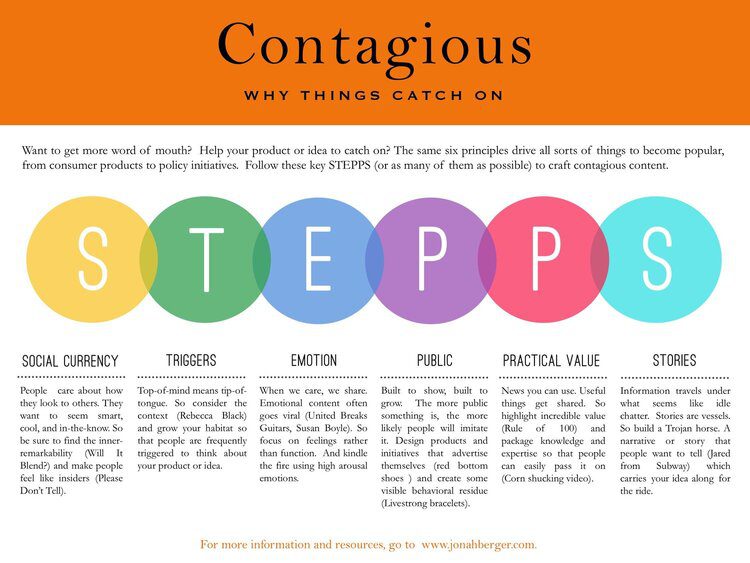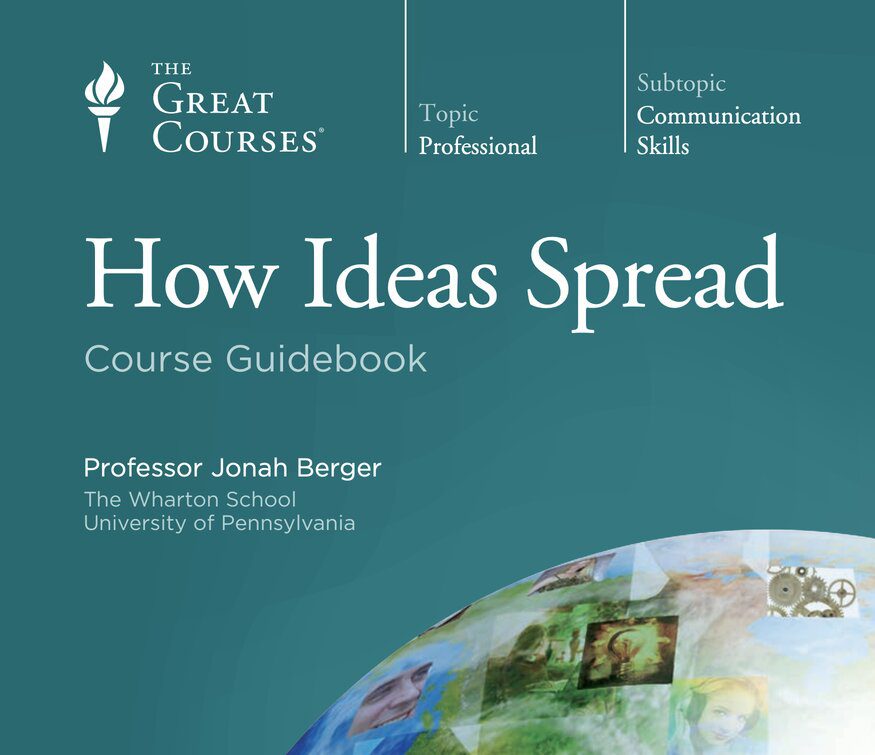Professor Jonah Berger is an Associate Professor of Marketing at the Wharton School of the University of Pennsylvania, where he has taught since 2007. He graduated with distinction from Stanford University with a B.A. in Human Judgment and Decision Making and received his Ph.D from Stanford Graduate School of Business. He has been a visiting faculty member at Duke University and Cornell University.
Professor Berger studies social dynamics—why products, ideas, and behaviors become popular. He examines how individual decision making and social influence among people generate collective outcomes, such as social contagion and trends. His work mixes psychology, sociology, marketing, and economics to understand human behavior and its implications for collective outcomes.
Professor Berger is the author of Contagious: Why Things Catch On, which appeared on the best-seller lists of The New York Times and The Wall Street Journal and translated into almost 30 languages. His other books include Invisible Influence: The Hidden Forces that Shape Behavior and The Catalyst: How to Change Anyone’s Mind.
Here are my favourite take aways from viewing, Jonah Berger’s Great Courses Class: How Ideas Spread:
The Scope
- Things often catch on and become popular. Movies become blockbusters, and books make the best-seller list. Rumors circulate widely, and political ideas become the talk of the town. But one important consideration is why some things succeed and spread while others fail. Some catchphrases propagate, and others languish. Some rumors circulate extensively, but others die quickly.
Some ideas propagate so effectively that they end up invading entire populations. But why? What separates contagious ideas from those that are less contagious?
- This course examines the surprising science behind why things catch on. From movies and consumer products to exercise trends and workplace rumors, our daily lives are filled with examples of things that catch on and die out. But while it’s easy to identify examples of popular products and ideas, we often understand less about how they got that way.
Social Epidemics—Why Things Catch
- Ideas spread from person to person, but how far they go depends on the pattern of connections between people. The goal of the science of how ideas are spread is to understand what leads products, ideas, and behaviors to diffuse and become popular—and what leads them to die out and become abandoned.
- A social epidemic is a situation where something diffuses through a population. It starts with one person, or a small set of people, and spreads to infect a broader set. Rather than spreading through the air, for example, social epidemics spread via social influence— one person’s behavior impacting another person’s.
It’s not random or luck why some things succeed or fail. There’s a science behind it; a set of key principles explain why some things succeed and others fail. And at a high level, these principles all center around us—the way we’re built.
Individual Psychology, Social Influence, and Social Networks
To understand why some things succeed and others fail, we’ll need to understand three key aspects:
- Individual Psychology, to understand how people process information and why we remember
some things and not others; - Social Influence, to understand how things spread between people (why we pass along certain news and information and when and why we imitate or deviate from those around us); and
- Social Networks, to understand how the pattern of social ties impacts the spread of information and influence and
whether certain individuals within that network are more influential than others.
Individual Psychology
- Characteristics of individual psychology help us understand the science of stickiness, or what makes ideas stick. We remember some ads we heard 10 years ago but can’t seem to remember where we put our keys yesterday. Some things stick in our memory while others go in one ear and out the other.
Social Influence
- Social influence is like a magnet. Sometimes it attracts, and sometimes it repels. We also see divergence in human behavior: when people avoid what other people are doing. There are conditions when people conform versus diverge. These conditions often explain why you might have to pay more to get products with a smaller logo and why once-popular things often become unpopular.
Consumer Psychology
- Exposure is the act of being exposed to concepts or information. Without exposure to information, there is no opportunity to process it.
- One big impact of exposure is awareness. It’s pretty difficult to purchase a product if you’re not aware that it exists, so one key goal of marketing and advertising is to expose people to the product.
Exposure also influences liking. The more you see something, the more you like it. This is known as the mere exposure effect.
Perception
• Once people have been exposed to information, they have to interpret it. And subtle cues can impact how we interpret things—how we perceive them.
The placebo effect happens when someone takes a medication that he or she perceives will
help, although it actually has no proven therapeutic effect for his or her particular condition.
Memory
- In order for ideas to spread, we need to keep them in our memory. Once we’ve been exposed to something and the information around that thing affects how we perceive it, what affects whether we remember it?
- The associative network model of memory is that there is a semantic network of ideas or nodes in memory where related ideas are connected. These links get formed through repeated association
Triggers
- A trigger is any stimulus in the environment that makes us think about a related concept or idea—any sight, sound, smell, etc., that makes us think of something, even though that thing may not be present at the moment. This works based on cognitive psychology— exposure, perception, and memory. If two things are connected, seeing one can activate the other.
Frequency
- How frequently things come to mind depends in part on how frequently they are triggered. So, things that are triggered more often should come to mind more often and be more likely to be chosen.
Simple Rules to Make Ideas Stick
Simplicity
- The first principle of what makes messages stick is simplicity. Less is sometimes more. The simpler and easier to understand an idea is, the more likely people are to remember it.
Unexpectedness
- More unexpected things are more likely to be remembered. Things can be unexpected for a number of reasons. One is that they violate expectations by breaking a pattern.
Concreteness
- Concreteness is another factor that makes things memorable. If you look at sticky rumors or urban legends, you’ll notice that they often use very concrete language, such as words written in lipstick on the mirror. Such concrete language makes messages memorable because it helps the listener visualize what is being talked about. You can almost see the red color of the lipstick if you close your eyes.
Credibility
- The final factor that makes messages sticky is credibility. The more credible the message, the more likely people are to believe it and remember it.
The Social Influence of Conformity
Conformity: Information
- People tend to follow the behavior of those around them. We listen to the same music as our friends, buy similar cars to our neighbors, and follow the same religions as our parents
Informational Influence.
- Conformity happens for two reasons. The first is about information. One reason people conform is because they are trying to figure out the right thing to do in a given situation. People imitate others, in part, because others’ choices provide useful information.
Conformity: To Fit In
- The second reason people conform is to fit in. In general, people like to be liked. We want people to think positively of us and avoid being ostracized. So, sometimes we go along to fit in.
The Social Influence of Divergence
Signaling
- People often buy things for what they do, but they also buy things for what they mean, or signal.
STEPPS Framework

- There is a science behind why people talk and share. In fact, there are six key factors that drive people to talk and share, regardless of whether the shared things are products, ideas, news, or rumors.
- The acronym STEPPS can help you remember these six key factors: social currency, triggers, emotion, public, practical value, stories. Each of these six factors is a psychological principle that drives people to pass information on and share it with their friends.
Further Reading
- Contagious: Why Things Catch On
- Invisible Influence: The Hidden Forces that Shape Behavior
- The Catalyst: How to Change Anyone’s Mind.
- Diffusion of Innovations by Everett M. Rogers
- Made to Stick: Why Some Ideas Survive and Others Die by Chip Heath and Dan Heath
- Six Degrees: The Science Of A Connected Age by Duncan J Watts
All the best in your quest to get better. Don’t Settle: Live with Passion.




Comments are closed.